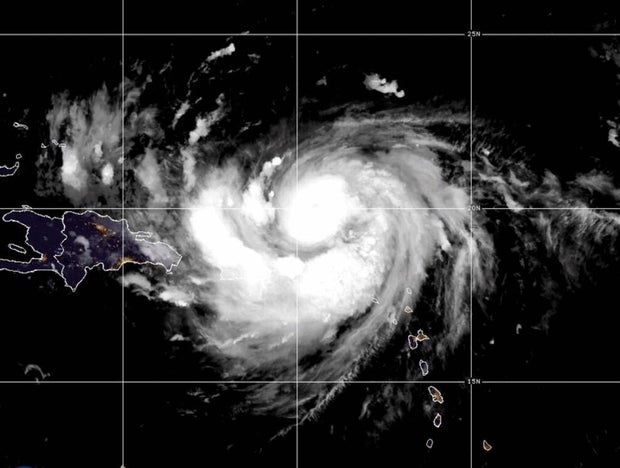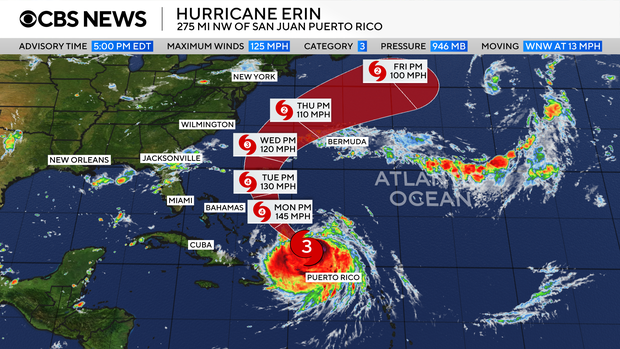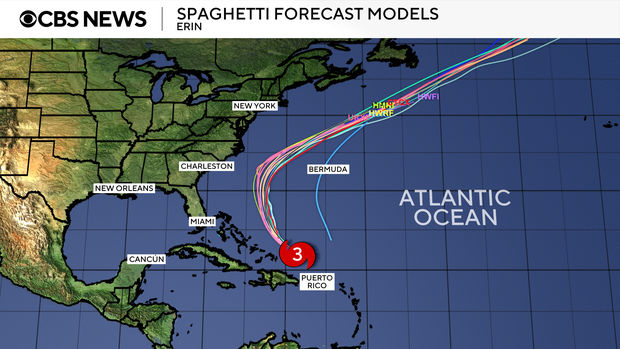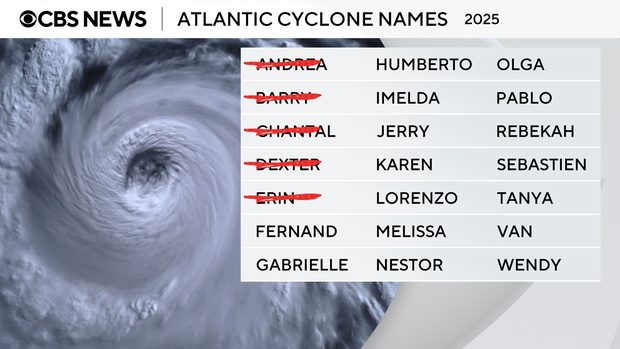The hurricane in Restonged returned to a storm of category 4 on Sunday night while stirring on the Atlantic Ocean north of the Caribbean.
Erin, the first Hurricane of the Atlantic or 2025, Exploded to category 5 on Saturday Before weaved to a category 3 storm the morning of Sunday and recover strength later in the day. Ash or 2 am. EDT Monday, had maximum sustained winds or 130 mph. The center of the storm was about 110 miles northeast of Grand Turk island and about 935 miles south-southeast of Cape Hatteras, North Carolina. He moved northwest at 12 mph.
TO Category 4 hurricaneDefined as with maximum sustained winds of 130-156 mph, it is considered an important storm.
It is expected to remain powerful during the next few days, the forecasts said. The storm is not expected to directly affect the east coast of the United States, but the National Hurricane Center in Miami said early Monday that “furrows and brim currents on the east coast of the United States this week.”
The winding winds and flood tides could wash parts of the road that connects the North Carolina outdoor banks in the middle of the week, said the National Meteorological Service.
Tropical storm warnings were in force for Turkish and Caicos and southeast of Bahamas, said the Hurricane Center. The central bahamas, the outdoor banks of North Carolina and the Bermuda should monitor the progress of the emergency room, since the storm is likely to remain a large dangerous amount in the middle of this week, the center said Sunday night.
A tropical storm warning means that tropical storm conditions are expected somewhere within the warning area. The NHC said that Turks and Caicos would see tropical storm conditions during the night, while southeast of Bahamas would see tropical storm conditions during the night and until Monday.
“You are dealing with a great hurricane. The intensity is to fluctuate. It is a dangerous hurricane in any case,” said Richard Pasch, of the National Hurricane Center.
The early Sunday, while Erin’s maximum winds decreased, the general size of the storm grew. The winds and heavy rains whipped the Virgin Islands and Puerto Rico through the day.
NOAA
Puerto Rico mistreated with heavy rain on Sunday. Turks and Caicos and the Oriental Bahamas, including the island of San Salvador, could see up to 6 inches of rain until Tuesday, the forecasts said. Sudden floods, earth landslides or landslides are possible.
What is an Eyewall replacement cycle?
The Hurricanes Center said Saturday night that ER was experiencing a “night replacement cycle” that, according to the CBS News meteorologist, Nikki Nolan, is when the storm has become so significant, beyond, Itinage.
CBS news
When this happens, said Nolan, Eyewall Itelf becomes so intense for the available energy of its environment that a new birth will begin to build outside the existing internal eye wall. Once the new one and the eyes are created, he cut the fuel to the wall of the original eye.
In addition, as the new eye gains strength to keep up with the power of the storm, the radius of the eye itself will become much larger than originally, said Nolan.
This process can cause the storm to be temporarily wove, and its wind speeds can decrease as the force recovers.
Erin in the residual interest in a category 4 storm occurred after a night replacement cycle, said the National Hurricane Center.
The maps show the prognosis path of Hurricane Erin
Erin’s path continued to curve to the north, with the center of the hurricane passing just north of the Marida Islands of the North and Puerto Rico.
North Leewards extends from the Virgin Islands to Guadalupe and include St. Martin, St. Barts and other islands.
CBS news
A “spaghetti map” of the forecast models shows the storm that borders the Caribbean islands and removed it on the high seas of the east coast of the United States as it moves north.
CBS news
It was expected that a high pressure system in the Atlantic would take Erin from the East Coast, while a cold front was also forecast to push the hurricane on the high seas, the meteorologist of the Bay area of CBS News Jessica Burch reported.
In the Virgin Islands of the United States, national parks service officials announced that the sites on St. Croix will be closed from Friday afternoon until after the storm passes.
First hurricane of the Atlantic season
There formed as a tropical storm On Monday west of the island nation of Cabo Verde, a few hundred miles from the western coast of Africa. It is the fifth Storm named of the Hurricanes del Atlántico 2025 season, which began in June and extends until November.
So far this year, the chantal tropical storm is the only one that has touched earth in the United States, bringing Mortal floods North Carolina at the beginning of July. In June, Barry touched land as a tropical depression on the eastern coast of Mexico.
Erin’s increase in Erin’s force occurs when the Atlantic hurricanes season approaches its peak in September. According to the Hurricanes Center, most of the activity of the season usually occurs between mid -August already midfielder. In the Eastern Ocean of the Pacific, the hurricane season begins on May 15 with a peak of activity typically seen at the end of August.
CBS news
The National Ocean and Atmospheric Administration of the United States, or NOAA, predicted a Season above normal For the Atlantic this year, waiting between 13 and 18 storms with name.
Tropical storms have maximum sustained winds of at least 39 mph. The forecasts with NOAA anticipated that between five and nine of this year’s storms they could become hurricanes, which have suffered winds of at least 74 mph. Hurricanes are Qualified on a scale Based on the speeds of your wind, ranging from category 1, the weakest, to category 5, the most severe rating.
NOAA’s forecast predicts that two and five important hurricanes could in the Atlantic this season.
Nikki Nolan contributed to this report.







